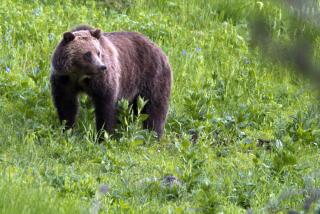Polar bears an older species than we thought, scientists say
- Share via
Do polar bears face obliteration as a species, not from starvation as the northern ice melts but through interbreeding with brown bears as changes in the climate bring them into contact with each other?
Authors of a new report say that’s a distinct possibility.
The closest relative of the polar bear is the brown bear — matings between grizzlies and polar bears sometimes happen in zoos or the wild, yielding very rare examples of hybrids known as grolar bears or pizzlies. Webb Miller of Pennsylvania State University and colleagues set out to examine the timing of the divergence between the two species, using a whole mess of DNA data — from contemporary brown bears, polar bears and black bears as well as from a polar bear that lived 110,000 to 130,000 years ago. (The ancient DNA was obtained from a jawbone found in Norway.)
The scientists’ conclusions, published in the Proceedings of the National Academy of Sciences:
— Yes, polar bears and brown bears are sister species, closer to each other than they are to black bears. The two diverged maybe 4 million to 5 million years ago, the authors estimate. That’s earlier by a lot than scientists had thought.
— Brown bears living on the Alexander Archipelago in Alaska are genetically more similar to polar bears than to brown bears living in other places. Evidently, there has been ancient mating (and thus DNA -mixing) going on between the two species in that spot.
— The conclusions are somewhat different than an analysis the scientists did of polar bears using a different kind of DNA, mitochondrial DNA, which suggested that polar bears split off from brown bears far more recently.
— The scientists have started to look at the genetic differences that might make polar bears, well, polar bears. That’s an investigation in its infancy, but they point to a few gene variants that might be linked to such traits as the white coat and high fat content of polar bear milk.
— Over the last 500,000 years, genetic variation among polar bears declined. This could have been caused by population contraction during a warm, interglacial period; when it got cooler again and bear numbers increased, they inherited genes from a relatively small number of individuals.
Finally, the scientists note that “the current trend toward an increasingly warmer climate in the Arctic has caused sea ice to retreat dramatically …. If this trend continues, it is possible that future polar bears throughout most of their range may be forced to spend increasingly more time on land, perhaps even during the breeding season, and therefore come into contact with brown bears more frequently.” If so, expect more pizzlies and grolars in the future.




